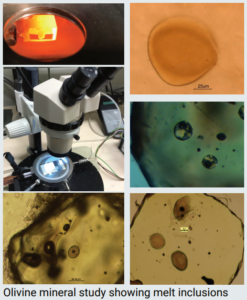16/11/22
The department of Earth Sciences at VU Amsterdam studies the Earth as a fully coupled system with emphasis on the interactions between the geo-, hydro-, bio-, cryo-, and atmosphere. Their main goal is to improve the understanding of the process that ultimately shape our planet and affect our daily lives.
These research efforts require a complex Earth system approach of both an experimental and theoretical nature. VU Amsterdam uses state of the art in-house and field laboratories, complemented with a suite of modelling and Earth Observation tools to achieve research goals.
Melt Inclusions (MI) are small droplets of silicate melt that are trapped in volcanic minerals during their growth from magmas, originated at depth within the Earth’s mantle. Researchers at the Earth science department of VU Amsterdam study these Melt Inclusions to retrieve chemical and physical characteristics of magmas at the moment of their origin.
The small melt droplets carry the DNA of deep magmas and can help to understand how continents and ocean islands in the ocean’s floor form. In order to properly study Melt Inclusions, they need to be in homogeneous state and consist only of glassy melt.
Unfortunately, >90% of naturally homogeneous trapped melt inclusions have undergone post-entrapment modifications during cooling, including partial to complete crystallization of the melt.
In these cases laboratory heating is needed to return the MI to its original homogeneous melt state, followed by rapid quenching of the melt to produce a homogeneous glass phase before microanalysis can be undertaken.
This requires specialized equipment which is very difficult to manufacture.
Ceramic was selected as the base material for the heating stage of the testing equipment due to its ability to withstand extreme temperatures. The heating stage was constructed by the Earth Science department of Vrije Universiteit Amsterdam and needed to perform high-T micro thermometric experiments for the homogenization of melt inclusions.
The tool’s unique construction allowed for the homogenization of Melt Inclusions with 50-100 minerals at the same time in one heating/quenching experiment. VU Amsterdam attempted to use 3D printing from other vendors, but they determined that only Nano Dimension’s Admaflex technology was suitable for the task.
Formlabs vs Admaflex Ceramic 3D Print

The heating stage printed with the Admaflex Technology enabled returning the Melt Inclusions to their original homogeneous state, which allowed the university to determine their chemical composition and related isotopes.
“We tried making the ceramic parts with our Formlabs polymer 3D printer, but this wasn’t successful. With the help of Admatec’s ceramic 3D printing knowledge and expertise we’ve installed the heating stage and are now able to study MI.” – Jacob Arends, Technical Research/Education at Vrije Universiteit Amsterdam